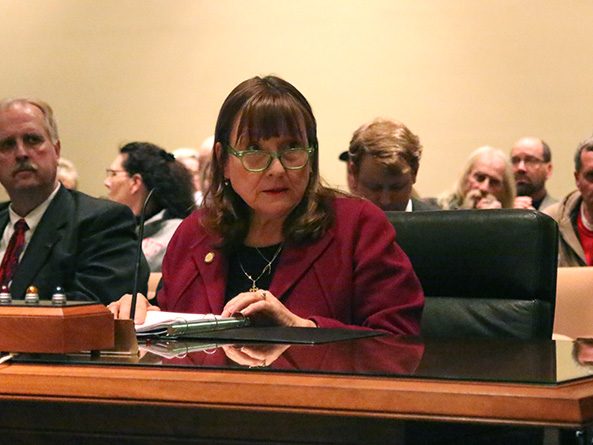Income-based valuation of ag land proposed
Land used for farming and ranching would be valued according to its ability to produce income under a bill heard by the Revenue Committee Feb. 8.
LB338, introduced by Sen. Lydia Brasch of Bancroft on behalf of Gov. Pete Ricketts, would base valuations on land’s projected income and commodity prices instead of solely on the land’s market value.
Brasch said the proposed method is fairer than the current one and is at least part of the solution to high property taxes on agricultural land.
“Today taxes are so bad that many farmers and ranchers wonder if they will even be able to keep their farms,” she said. “In good conscience, we cannot simply walk away from this problem.”
To establish an income range for each land capability group in the state, the state property tax administrator would use U.S. Department of Agriculture data on average yield for commodities appropriate to each land capability group and the prices of the commodities on which the average yield is based. The calculation also would include land sales from the previous three years.
The administrator then would provide his or her findings and recommendations to county assessors no later than Jan. 1 each year. Assessors would use that information to assign a use value to each parcel. If assessors disagree with the property tax administrator’s income ranges, they could petition for a change.
The property tax administrator would ensure that capitalization rates result in a statewide agricultural use value between 60 and 75 percent of actual value for each class of land. Under current law, agricultural and horticultural land are valued at 75 percent of actual value. The bill also requires that aggregate agricultural value will not increase by more than 3.5 percent from the prior year.
Ricketts testified in support of the bill, saying it would put Nebraska in line with other agricultural states, such as South Dakota, Kansas and Iowa, that use income-based valuations. He said the change would make it easier for farmers and ranchers to predict how much their property taxes will rise each year and prevent steep increases like the one seen in recent years. If this method had been in place in 2017, Ricketts said, total agricultural land valuations would have gone down by $2.2 billion.
“This income potential assessment will be more fair to our farmers and ranchers because it’s tying the value of that property more closely to the amount of income that can be earned off of that property,” he said.
Ruth Sorensen, state property tax administrator, also testified in support of the bill, saying that statewide valuation of agricultural land has increased 264 percent since 2006. The proposed change would average out good years and bad years, she said, and it would maintain county assessors’ responsibility for assigning value to a piece of land.
“This is something that we can do, and it’s something that we should do,” she said.
Steve Wellman, a farmer from Syracuse, also spoke in support of the bill. He said an income-based valuation method would eliminate inflated valuations caused by artificially high sale prices and would more accurately reflect an owner’s ability to operate a farm or ranch.
“I believe income-based valuations will be an improvement for Nebraska farmers and ranchers while still providing funding for our schools, counties and other taxing entities,” Wellman said.
Steve Nelson, president of the Nebraska Farm Bureau Federation, spoke in support of the bill but said it falls short of addressing problems with how the state values agricultural land. The proposed method’s mix of income-based and market-based valuations would not achieve the same effect seen in other states that use a purely income-based approach, he said.
“At the end of the day, this is a land valuation bill, not a bill which fundamentally fixes the property tax problem,” he said.
Jordan Rasmussen of the Center for Rural Affairs spoke in opposition to the bill, saying that it would not provide substantial tax relief or long-term property tax reform. For example, she said, the owner of a 40-acre parcel of irrigated land in Saunders County valued at $237,000 in 2016 would see a tax savings of less than $150 if the bill were implemented. However, local governments likely would face revenue shortfalls as a result of the change.
“To address these shortfalls,” Rasmussen said, “local entities are likely to raise levies to meet their budget needs, thereby eliminating savings gained by decreasing property taxes.”
Also in opposition to LB338, Mary Lou Block, a farmer from Custer County, said that the proposed system could limit a farmer’s flexibility in deciding which crops to grow. She said the valuation of her land has increased 281 percent in the last 10 years and the bill would not provide enough tax relief soon enough.
“That is like a puff of air in a Nebraska tornado,” Block said.
The committee took no immediate action on the bill.


